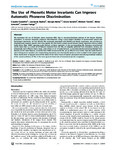The Use of Phonetic Motor Invariants Can Improve Automatic Phoneme Discrimination
| dc.contributor.author | Castellini, C | en |
| dc.contributor.author | Badino, L | en |
| dc.contributor.author | Metta, G | en |
| dc.contributor.author | Sandini, G | en |
| dc.contributor.author | Tavella, M | en |
| dc.contributor.author | Grimaldi, M | en |
| dc.contributor.author | Fadiga, L | en |
| dc.date.accessioned | 2017-06-23T15:48:15Z | |
| dc.date.available | 2017-06-23T15:48:15Z | |
| dc.identifier.issn | 1932-6203 | en |
| dc.identifier.other | 9 | en |
| dc.identifier.uri | http://hdl.handle.net/10026.1/9543 | |
| dc.description | affiliation: Castellini, C (Reprint Author), Univ Genoa, LIRA Lab, Genoa, Italy. Castellini, Claudio; Metta, Giorgio; Tavella, Michele, Univ Genoa, LIRA Lab, Genoa, Italy. Badino, Leonardo; Metta, Giorgio; Sandini, Giulio; Fadiga, Luciano, Italian Inst Technol, Genoa, Italy. Grimaldi, Mirko, Salento Univ, CRIL, Lecce, Italy. Fadiga, Luciano, Univ Ferrara, DSBTA, I-44100 Ferrara, Italy. article-number: e24055 keywords-plus: SPEECH-PERCEPTION; RECOGNITION research-areas: Science & Technology - Other Topics web-of-science-categories: Multidisciplinary Sciences author-email: claudio.castellini@dlr.de funding-acknowledgement: European Commission [NEST-5010, FP7-IST-250026] funding-text: The authors acknowledge the support of the European Commission project CONTACT (grant agreement NEST-5010) and SIEMPRE (grant agreement number FP7-IST-250026). The funders had no role in study design, data collection and analysis, decision to publish, or preparation of the manuscript. number-of-cited-references: 31 times-cited: 0 journal-iso: PLoS One doc-delivery-number: 817OO unique-id: ISI:000294683900024 | en |
| dc.description.abstract |
We investigate the use of phonetic motor invariants (MIs), that is, recurring kinematic patterns of the human phonetic articulators, to improve automatic phoneme discrimination. Using a multi-subject database of synchronized speech and lips/tongue trajectories, we first identify MIs commonly associated with bilabial and dental consonants, and use them to simultaneously segment speech and motor signals. We then build a simple neural network-based regression schema (called Audio-Motor Map, AMM) mapping audio features of these segments to the corresponding MIs. Extensive experimental results show that (a) a small set of features extracted from the MIs, as originally gathered from articulatory sensors, are dramatically more effective than a large, state-of-the-art set of audio features, in automatically discriminating bilabials from dentals; (b) the same features, extracted from AMM-reconstructed MIs, are as effective as or better than the audio features, when testing across speakers and coarticulating phonemes; and dramatically better as noise is added to the speech signal. These results seem to support some of the claims of the motor theory of speech perception and add experimental evidence of the actual usefulness of MIs in the more general framework of automated speech recognition. | en |
| dc.language | English | en |
| dc.language.iso | English | en |
| dc.publisher | PUBLIC LIBRARY SCIENCE | en |
| dc.title | The Use of Phonetic Motor Invariants Can Improve Automatic Phoneme Discrimination | en |
| dc.type | Journal Article | |
| plymouth.volume | 6 | en |
| plymouth.journal | PLOS ONE | en |
| dc.identifier.doi | 10.1371/journal.pone.0024055 | en |
| plymouth.organisational-group | /Plymouth | |
| plymouth.organisational-group | /Plymouth/Faculty of Science and Engineering | |
| plymouth.organisational-group | /Plymouth/REF 2021 Researchers by UoA | |
| plymouth.organisational-group | /Plymouth/REF 2021 Researchers by UoA/UoA11 Computer Science and Informatics | |
| dc.rights.embargoperiod | Not known | en |
| rioxxterms.versionofrecord | 10.1371/journal.pone.0024055 | en |
| rioxxterms.licenseref.uri | http://www.rioxx.net/licenses/all-rights-reserved | en |
| rioxxterms.type | Journal Article/Review | en |


